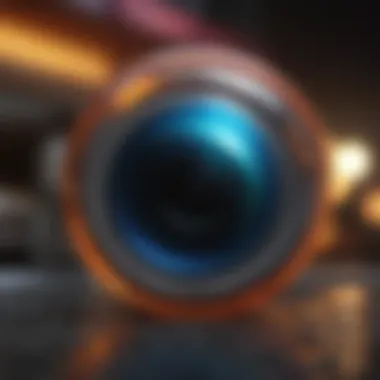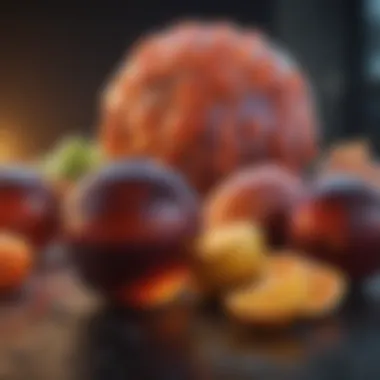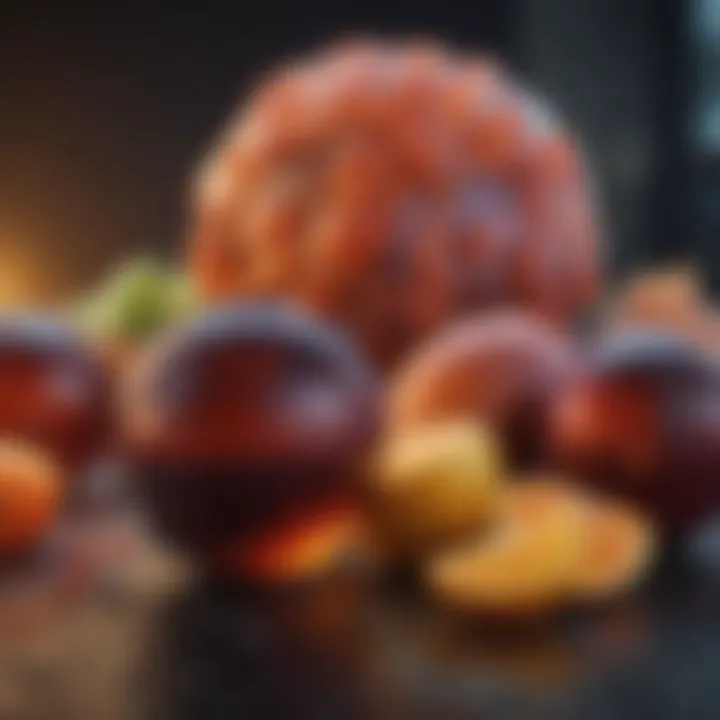Understanding Cy3 Dye: Applications and Mechanisms


Intro
Cy3 dye stands as a pivotal tool in the realm of fluorescent labeling, significant not only for its vibrant fluorescence but also for its diverse applications in molecular biology and biochemistry. This article seeks to unravel the complexities surrounding Cy3 dye, from its chemical properties to its practical utility in scientific investigations. The objective is not only to present a thorough understanding of Cy3 dye but also to elucidate current trends in research while hinting at future directions that this vital compound might take in the pursuit of scientific advancement.
Research Overview
Summary of Key Findings
Cy3 dye is recognized for its effectiveness in various applications, such as fluorescence microscopy, DNA sequencing, and flow cytometry. Its chemical structure supports high conjugation, leading to robust fluorescent properties. Key findings emphasize its efficacy in these domains, often outperforming traditional fluorescent markers in sensitivity and brightness.
In practical settings, Cy3 dye has shown significant promise in enhancing the visualization of biological structures, enabling researchers to dissect intricate cellular interactions with precision.
Relevance to Current Scientific Discussions
In recent years, the demand for reliable and efficient fluorescent markers has surged, making Cy3 dye relevant to ongoing discussions in scientific research. The dye's compatibility with other fluorescence techniques allows for multiparametric studies, facilitating broader investigations across various biological contexts. Furthermore, as research into novel applications continues, Cy3 dye serves as a benchmark against which emerging alternatives can be measured.
Methodology
Research Design and Approach
This article employs a comprehensive literature review approach, evaluating existing studies that focus on Cy3 dye's applications and mechanisms. The exploration is structured to highlight key insights and historical developments while paying close attention to recent advancements and innovative methods that showcase the dye’s versatility.
Data Collection and Analysis Techniques
Data has been gathered from credible sources, including peer-reviewed journals and established publications in the fields of molecular biology and biochemistry. By synthesizing evidence from these sources, the narrative aims to present a well-rounded perspective on Cy3 dye's impact, limitations, and potential future directions in the field.
"A thorough understanding of Cy3 dye is integral for researchers aiming to utilize modern fluorescence techniques effectively."
The following sections will delve deeper into the chemical attributes of Cy3 dye, its mechanisms of fluorescence, applications, and the landscapes of future research endeavors.
Prolusion to Cy3 Dye
The significance of Cy3 dye in scientific research cannot be overstated. This fluorescent compound has become a fundamental tool in various applications, particularly in molecular biology and biochemistry. Understanding Cy3 dye entails grasping its unique properties, its historical context, and its broad applications in research.
Definition and Characteristics
Cy3 dye, chemically known as 3,3'-diethylthiadicarbocyanine iodide, is a part of the cyanine dye family. It exhibits bright fluorescence when excited by suitable wavelengths of light. Its peak absorption typically occurs around 550 nm, with emission extending to approximately 570 nm. This characteristic makes it particularly effective for fluorescence microscopy, where visualization of components at a cellular level is critical.
In terms of stability, Cy3 dye shows a robust resistance to light, contributing to its longevity and reliability during experiments. However, it is essential to note that this dye can be prone to photobleaching under prolonged exposure to intense light. The chemical structure consists of a central conjugated system which is pivotal for its spectral properties, directly influencing its fluorescence behavior.
Historical Development
The development of Cy3 dye traces back to the advancements in synthetic dyes in the 1990s. During this period, a considerable emphasis was placed on creating fluorescent markers that were not only effective but also larger in their application scope compared to their predecessors. Cy3 emerged as a new solution, providing enhanced brightness and versatility in research settings. Researchers quickly adopted this dye due to its favorable qualities, leading to its integration into various protocols, including DNA sequencing and in situ hybridization techniques. As the appreciation of fluorescence techniques grew, so did the demand for dyes like Cy3, which facilitated critical visualizations in complex biological systems.
This trajectory of development underscores the importance of Cy3 dye in modern scientific exploration. Its continuous utilization reflects evolving methodologies and reinforces its value in the broader landscape of molecular biology.
Chemical Properties of Cy3 Dye
The chemical properties of Cy3 dye are fundamental to its function in various scientific applications. Understanding these properties allows researchers to utilize Cy3 dye effectively in experiments. The dye is known for its beneficial characteristics, including stability and specificity, which are essential for reliable results. Moreover, these properties dictate how Cy3 interacts with biological samples and how it is detected in various assays.
Molecular Structure
Cy3 dye consists of a specific molecular arrangement that contributes greatly to its fluorescent properties. The core structure includes a conjugated system that allows for effective electron delocalization. This is crucial, as it facilitates the absorption of photons and ultimately leads to fluorescence.
Additionally, various functional groups attached to the molecular framework determine its solubility and compatibility with different solvents and biological systems. The structural integrity of Cy3 also plays a role in reducing non-specific binding, making it a more targeted choice for labeling in biological research.
Spectroscopic Features
The spectroscopic features of Cy3 dye are critical to its efficacy in research. Spectroscopy describes the interaction of light with matter, and for Cy3, this involves both absorption and emission phenomena. These features are vital when considering how the dye performs in practical applications.
Absorption Spectra
Absorption spectra of Cy3 dye reveal the wavelengths of light the dye can absorb. This characteristic is a key aspect, as it determines how well the dye can be excited by specific light sources. Typically, Cy3 exhibits a strong absorption peak in the green region of the spectrum, around 550 nm. This makes it compatible with common light sources used in fluorescence experiments like lasers and LEDs.
The broad absorption range further confirms Cy3's versatility, allowing it to be paired with corresponding emission-detecting components, enhancing the overall sensitivity of assays. This specific aspect of absorption contributes to the dye's popularity in fluorescence microscopy and DNA sequencing experiments, as it provides clear signals against a low background.
Emission Spectra
Emission spectra represent how Cy3 dye releases light after being excited. The dye predominantly emits in the orange-red range, around 570 nm. This feature is important, as it distinguishes the signal from other potential fluorescent markers used in multi-labeling experiments.
The key characteristic of the emission spectrum is its relatively high quantum yield, indicating that a significant proportion of absorbed photons result in emitted light. This quality of Cy3 is another reason for its favorable selection in various biological assays since higher yield translates to improved visibility and accuracy in detection.


Some drawbacks exist, however. The emission spectrum can occasionally overlap with other dyes, which might lead to confusion in multiplex experiments. Yet, when used appropriately, the unique emission feature of Cy3 enhances its functioning in research methodologies.
"Understanding the absorption and emission properties of Cy3 dye is essential for optimizing its use in fluorescence-based applications."
By elucidating the chemical properties of Cy3 dye, researchers can better appreciate its potential and limitation in various applications. This foundational knowledge supports informed decision-making in experimental design across disciplines.
Synthesis of Cy3 Dye
The synthesis of Cy3 dye is critical in determining its performance in various applications. Understanding how this dye is produced not only sheds light on its availability but also highlights the intricate details that affect its chemical properties. The methods and techniques involved in the synthesis can directly influence the outcomes in applications like fluorescence microscopy and DNA sequencing. Therefore, a deep dive into its synthesis helps researchers and practitioners to optimize protocols and improve results.
Synthesis Methods
The synthesis of Cy3 dye typically involves several key methods. The most common one is the reaction between appropriately substituted aromatic compounds and specific reactive intermediates. This method is notable because it allows for the creation of high-purity dye with well-defined characteristics suitable for various applications.
One well-documented method involves the use of a condensation reaction between chromophores. These chromophores are molecular structures that lead to the color of the dye. The outcome of this reaction can be influenced by factors such as temperature and pH. Several other methods exist, such as:
- Bromination: Involving the introduction of bromine atoms to activate certain positions on the aromatic ring.
- Acylation: Gaining stability and electrophilicity, making the dye more reactive in desired applications.
This variation in methods allows researchers to select the best route depending on the intended application of the dye. Each method carries different advantages, such as yielding different levels of fluorescence intensity or stability.
Purification Techniques
Purification is a crucial step after synthesis to ensure the dye achieves its desired specifications for use. Impurities can affect the fluorescence characteristics of Cy3 dye, which can lead to inaccurate results in experimental settings.
Various techniques can be employed for purification:
- Column Chromatography: This method separates components in a mixture based on their different affinities to the stationary phase. It is a widely accepted technique among chemists.
- Recrystallization: Useful for enhancing the purity of crystalline products formed during the synthesis. It involves dissolving the dye in an appropriate solvent and allowing it to crystallize under controlled conditions.
- Ultrafiltration: This technique uses a membrane to filter out undesired molecular sizes and is particularly effective in liquid solutions.
The choice of purification technique often depends on the initial purity of the synthesized dye and the specific requirements of the final application. Overall, effective purification not only enhances the quality of Cy3 dye but also ensures reproducibility in scientific experiments.
"The synthesis and purification steps are fundamental to achieving high-quality Cy3 dye, which is essential for precise assays and innovative research."
By understanding both synthesis methods and purification techniques, scientists can maximize the performance of Cy3 dye in a myriad of scientific applications.
Applications of Cy3 Dye
The applications of Cy3 dye are significant across various scientific fields, especially in molecular biology and biochemistry. This fluorescent dye allows researchers to visualize and analyze biomolecules with great precision. Importantly, its applications benefit from its unique chemical properties and strong fluorescent characteristics. The relevance of Cy3 dye extends into several essential techniques, each playing a vital role in biological research and diagnostics.
Fluorescence Microscopy
Fluorescence microscopy is one of the most common applications of Cy3 dye. This technique harnesses the fluorescent properties of Cy3 to provide high-resolution imaging of cells and tissues. By binding specifically to target molecules, Cy3-labeled probes facilitate the visualization of cellular components. This is crucial for studying interactions between proteins, gene expression, and cellular structures.
Key benefits of using Cy3 in fluorescence microscopy include:
- High sensitivity: The dye can detect low-abundance targets, making it invaluable for experiments where sample quantity is limited.
- Versatility: Cy3 can be used in various labeling strategies for different types of biological samples, including fixed cells and tissue sections.
- Compatibility: It works well alongside other fluorescent dyes, allowing for multiplexing studies to observe multiple targets simultaneously.
DNA Sequencing Techniques
Cy3 dye plays a crucial role in DNA sequencing techniques, particularly in sequencing by synthesis methods. Its fluorescent properties enable the incorporation of Cy3-labeled nucleotides during DNA synthesis, which are then detected during the sequencing process. This enhances the accuracy of results and offers a clearer analysis of data.
Considerations for using Cy3 in DNA sequencing include:
- Increased throughput: Cy3 allows simultaneous detection of several sequences, enabling high-throughput sequencing applications.
- Improved clarity of results: The dye's fluorescence minimizes background noise, facilitating better differentiation between signals of interest.
Flow Cytometry
Flow cytometry utilizes Cy3 dye for cell analysis. In this technique, cells are stained with Cy3-labeled antibodies that bind to specific markers. Flow cytometry then sorts and counts these cells based on their fluorescent signals.
Using Cy3 in flow cytometry offers several advantages:
- Quantitative analysis: The intensity of the fluorescent signal correlates to the amount of target protein, allowing for quantitative measurements.
- Rapid processing: Flow cytometry can analyze thousands of cells per second, making it efficient for comprehensive studies.
In Situ Hybridization
In situ hybridization leverages Cy3 dye to detect specific RNA sequences in tissue samples. This application enables researchers to visualize the spatial distribution of gene expression within tissues. Cy3-labeled probes provide a clear signal in hybridization assays, contributing to an understanding of cellular processes at the molecular level.
Main points of consideration when using Cy3 for in situ hybridization:
- Specificity: Utilizing exact matches between probes and target sequences enhances accuracy in identifying expressed genes.
- Sensitivity: Even low-abundance RNA targets can be detected due to the strong fluorescence of Cy3.
To summarize, the applications of Cy3 dye are diverse and impactful in modern scientific research. From fluorescence microscopy to flow cytometry and in situ hybridization, Cy3 dye continues to prove its worth in providing clear, accurate, and sensitive observations in molecular biology.


Mechanisms of Fluorescence
Fluorescence is a critical phenomenon that plays a central role in the utilization of Cy3 dye across various scientific domains. Understanding the mechanisms behind fluorescence allows researchers to optimize their experimental conditions and achieve the desired results with high sensitivity. The fluorescence process is a complex interplay of multiple factors that influence the behavior of the dye under various conditions. This section delves into these mechanisms, addressing both the fundamental principles and practical considerations.
Fluorescence Process
The process of fluorescence occurs when a molecule absorbs photons at a specific wavelength and subsequently re-emits them at a longer wavelength. For Cy3 dye, the excitation typically occurs in the visible range, leading to a vibrant emission spectrum that can be detected through specialized imaging techniques.
- Excitation Phase: In this initial phase, the molecule absorbs energy from light, promoting electrons from a ground state to an excited singlet state.
- Relaxation: Following excitation, the excited electron quickly relaxes to a lower excited state. This occurs through non-radiative processes, which do not emit light.
- Emission Phase: Finally, the electron returns to the ground state, releasing energy as a photon. The emitted light, typically of longer wavelength, is what researchers capture in applications like fluorescence microscopy and flow cytometry.
This entire sequence happens on a timescale of nanoseconds. The efficiency of this process significantly affects how effectively Cy3 dye can be utilized in various applications. The design and choice of Cy3 ensure compatibility with common equipment, making it a favored choice among researchers.
Factors Affecting Fluorescence
Several factors can influence the effectiveness of fluorescence in Cy3 dye, including:
- Environment: The local environment around the dye can impact its fluorescence efficiency. Factors such as pH, ion concentration, and the presence of other molecules can either enhance or quench fluorescence.
- Concentration: At higher concentrations, self-quenching can occur, where adjacent molecules interfere with each other's fluorescence, leading to reduced signal intensity.
- Temperature: Fluctuations in temperature can alter the vibrational energy levels of molecules, impacting their emission characteristics.
- Solvent Properties: The choice of solvent can also affect the solvation dynamics, influencing how the dye interacts with light.
A thorough understanding of these factors enables researchers to manipulate conditions for optimal fluorescence, thereby maximizing the effectiveness of Cy3 dye in their experiments.
"Understanding the fluorescence process and the factors that influence it is essential for anyone working with fluorescent dyes. It is through this knowledge that effective experimental setups can be designed."
By grasping these mechanisms, one can enhance the utility of Cy3 dye in the rapidly evolving fields of molecular biology and biochemistry.
Advantages of Using Cy3 Dye
Cy3 dye has gained popularity in scientific research due to its unique properties. These properties contribute to its advantages in various applications, particularly in molecular biology. Understanding the strengths of Cy3 dye is essential for researchers deciding which fluorescent dye to utilize.
High Sensitivity and Specificity
One of the principal benefits of Cy3 dye lies in its high sensitivity. This characteristic allows it to detect even minute quantities of target molecules. In fluorescence microscopy, for example, Cy3's sensitivity ensures that researchers can visualize samples that contain low concentrations of the biomolecules of interest. This ability to detect small signals is crucial in diagnostic research and clinical applications, where accurate identification of specific genes or proteins can inform treatment decisions.
Moreover, Cy3 dye exhibits excellent specificity. It enables clear labeling of target molecules without significant background noise. This specificity results from the selective binding of the dye to particular sequences or structures. Consequently, scientists can gather more accurate data from experiments.
The sensitivity and specificity of Cy3 dye make it a prime choice where precision is key.
Stability and Longevity
Another advantage of Cy3 dye is its stability and longevity under laboratory conditions. Cy3 exhibits remarkable photostability, meaning it retains its fluorescent properties even after exposure to light. This characteristic is essential when conducting long-term experiments that require consistent imaging over extended periods.
In addition to its photostability, Cy3 dye shows resilience against various chemical conditions. This resilience allows it to perform effectively in diverse environments, such as varying pH levels or the presence of certain biochemical substances.
Researchers benefit from this stability as it reduces the need for frequent dye replacement, saving both time and resources. Cy3's longevity ultimately enhances experimental reliability, ensuring that the results are a true reflection of the samples being observed.
Limitations of Cy3 Dye
Cy3 dye, despite its widespread utility in scientific applications, has its limitations that warrant thorough examination. Understanding these constraints is essential for researchers looking to optimize their experiments with Cy3. This section highlights two significant limitations: photobleaching and variability in laboratory conditions. Each of these factors can affect the efficacy of Cy3 dye in various applications.
Photobleaching Issues
Photobleaching refers to the loss of fluorescence intensity over time due to prolonged exposure to excitation light. This phenomenon is particularly relevant when using Cy3 dye, as it depletes the dye's ability to emit light effectively. When Cy3 is continuously exposed to intense light sources, such as lasers in fluorescence microscopy or flow cytometry, the chromophore can undergo structural damage. This leads to a rapid decrease in fluorescent output.
The implications of photobleaching are vast. Reduced fluorescence can obscure the true signal in imaging applications, resulting in inaccurate data interpretation. Additionally, it can necessitate higher concentrations of the dye, potentially affecting the biological systems being studied. Researchers must account for photobleaching when designing experiments, implementing strategies such as using lower excitation intensity or employing chamber designs that limit photobleaching.
"Understanding the kinetics of photobleaching is crucial for optimizing fluorescent assays and obtaining reliable results."
Variability in Laboratory Conditions
Laboratory conditions can greatly influence the performance of Cy3 dye. Various factors, such as temperature fluctuations, pH levels, and ionic strength, can alter the behavior of the dye, resulting in inconsistent results across experiments. For instance, variations in temperature can affect the stability of Cy3, leading to differences in fluorescence intensity that may not be attributable to biological changes.
Additionally, differences in reagent purity and even the quality of the glassware employed can introduce variability. Continuous monitoring of these conditions is necessary for reproducibility. Researchers might consider standardizing their protocols and materials as much as possible to minimize variability. This approach will lead to more reliable and comparable data across different experiments.
In summary, while Cy3 dye serves vital roles in scientific research, it is essential for users to recognize and address its limitations. Understanding photobleaching and controlling laboratory conditions can lead to more accurate and reliable results, ultimately enhancing the dye's utility across various applications.
Comparative Analysis with Other Dyes
The section presents a comparative analysis of Cy3 dye in relation to other fluorescent dyes, notably Cy5. This comparison is crucial because it provides context for the strengths and limitations of Cy3 in scientific applications. Understanding how Cy3 aligns or diverges from alternatives helps researchers make informed choices about which dyes to use for specific experiments, thus enhancing the reliability and validity of their findings.
Cy5 and Cy3: Key Differences
Cy3 and Cy5 dyes are both popular choices within the realm of fluorescent imaging. However, they exhibit distinct differences that can influence experimental outcomes.


- Spectral Properties:
- Sensitivity:
- Applications:
- Absorption and Emission: Cy3 typically has a maximum excitation wavelength around 550 nm and emits light at approximately 570 nm. On the other hand, Cy5 is characterized by a longer-wavelength absorption peak, occurring around 650 nm and emitting light close to 670 nm. This significant difference in wavelengths allows for multifluorescent labeling in experiments, providing researchers with enhanced flexibility.
- Cy3 is known for its relatively high quantum yield, meaning it emits a considerable amount of fluorescence per absorbed photon. Conversely, Cy5, while having a lower quantum yield, compensates with improved photostability under intense excitation, making it advantageous in prolonged imaging scenarios.
- Cy3 is often used in applications such as fluorescence microscopy and DNA sequencing due to its strong brightness. Cy5, being more efficient in detecting low abundance targets, finds its niche in applications like flow cytometry and multiplex assays.
These differences dictate which dye might be more appropriate for a particular experiment. For example, when high sensitivity is required, Cy3 may be the preferred choice. However, if extended imaging time is paramount, Cy5 might be favored for its stability.
Emerging Alternatives
Research in the field of fluorescent dyes is constantly evolving. New dyes are being developed with improved properties to meet the changing needs of scientists. Some emerging alternatives to Cy3 and Cy5 include:
- Alexa Fluor Dyes: These dyes, such as Alexa Fluor 546 and Alexa Fluor 647, offer a broad range of excitation and emission spectra. Their enhanced stability makes them excellent candidates for long-term imaging.
- Atto Dyes: Another set of synthetic dyes that show remarkable brightness and photostability, Atto dyes like Atto 550 and Atto 647 N could replace Cy3 or Cy5 in certain contexts, especially where the photobleaching is a concern.
- Quantum Dots: These are semiconductor nanoparticles that exhibit fluorescent properties. They offer superior photostability and are useful in various imaging applications but require specific handling and preparation.
Trends in Cy3 Dye Research
Research on Cy3 dye is vital as it continues to evolve, enhancing its utility in diverse scientific applications. Understanding the latest trends provides crucial insights into how this compound can be improved and adapted for various needs. As researchers explore innovative synthesis methods and novel applications, the potential for Cy3 dye extends beyond traditional uses.
Innovations in Synthesis
The synthesis of Cy3 dye has seen significant advancements. New synthetic routes and improved methods can produce higher yields and more stable derivatives. Techniques such as:
- Green Chemistry Approaches: These methods minimize waste and use less hazardous materials. Encouraging sustainability in dye production is increasingly important.
- Microwave-Assisted Synthesis: This method accelerates reactions, which leads to time-efficient production processes.
Adopting these innovations not only enhances the efficiency of producing Cy3 but also contributes to a more sustainable approach in research. Furthermore, researchers are keen to develop derivatives of Cy3 that can facilitate better targeting and imaging in cellular studies.
Applications in New Scientific Fields
Cy3 dye's applications are expanding into fields beyond traditional molecular biology. Some notable areas include:
- Biomedical Engineering: Here, Cy3 dye is being used for imaging and tracking in tissue engineering applications.
- Environmental Science: Recent studies apply Cy3 for monitoring pollutants, where its fluorescence can indicate the presence of hazardous materials.
- Nanotechnology: Integration of Cy3 in nanomaterials enables new capabilities in sensing and imaging at the nanoscale.
These expansions illustrate Cy3's versatility. As researchers discover new applications, the dye's significance in the scientific community will likely increase.
"The evolution of Cy3 research demonstrates its remarkable adaptability in various scientific arenas."
In summary, trends in Cy3 dye research highlight a promising future. Innovations in synthesis methods ensure the dye remains in the forefront of research while its expanding applications open doors to novel uses. This ongoing evolution demonstrates the importance of Cy3 dye in addressing contemporary scientific challenges.
Future Perspectives
The exploration of Cy3 dye has been an integral part of advancements in fluorescence applications across multiple scientific disciplines. As we look forward, understanding the future perspectives surrounding Cy3 dye becomes essential for researchers, educators, and industry professionals. This section will focus on the evolving technologies in fluorescence and the dye's potential for broader applications. Both factors hold significant implications for enhancing methodologies and experimental setups in various fields.
Evolving Technologies in Fluorescence
The field of fluorescence is rapidly advancing, driven by innovations in imaging systems, dye formulations, and detection techniques. Recent developments aim to improve sensitivity, resolution, and specificity in fluorescence microscopy. This not only enhances the utility of Cy3 dye but also optimizes imaging in complex biological systems.
- Enhanced Detection: New detector technologies are enabling researchers to capture fluorescence signals with greater precision. These advancements in equipment can significantly improve the performance of Cy3 dye under various experimental conditions.
- Smart Fluorescent Probes: Research is ongoing into smart probes that can respond to specific cellular environments. These advanced systems can incorporate Cy3 dye alongside other fluorescent markers, allowing multi-modal imaging.
"The advancements in detection systems are revolutionizing the application scope of Cy3 dye, making it a critical tool in sophisticated imaging protocols."
- Multiplexed Imaging: The integration of Cy3 dye in multiplexing techniques allows researchers to visualize multiple biomarkers simultaneously. This capability helps in obtaining a comprehensive understanding of biological interactions and pathways.
These evolving technologies suggest that the role of Cy3 dye will expand, possibly leading to the development of new methodologies that will enhance its usage in diverse applications, from basic research to clinical diagnostics.
Potential for Broader Applications
As research continues to unveil the properties and utilities of Cy3 dye, its potential applications are set to grow beyond traditional uses in microscopy and flow cytometry.
- Clinical Diagnostics: Cy3 dye's stability and high sensitivity position it as a promising candidate for clinical applications. Its application in diagnostic assays may enhance the detection of biomarkers related to diseases, including cancer and infectious diseases.
- Drug Development: In pharmacology, Cy3 dye can help visualize drug interactions within cells. Understanding these interactions could lead to better drug formulations and therapeutic strategies.
- Environmental Monitoring: The resilience of Cy3 dye may also facilitate its adoption in environmental applications. For example, it can potentially be utilized in monitoring pollutants or toxins, providing real-time data in ecological studies.
By embracing these potential broadened applications, the scientific community can capitalize on the unique attributes of Cy3 dye, driving forward innovations that address real-world challenges.
In summation, the future of Cy3 dye looks promising. With evolving technologies and expanding application fields, there is significant scope for ongoing research and exploration. A proactive approach in this direction could unlock new frontiers in molecular biology, biochemistry, and beyond.
The End
The conclusion serves a significant role in synthesizing the information presented throughout the article. It encapsulates the main themes about Cy3 dye, emphasizing its applications, mechanisms, and future potential in various scientific domains. This summary not only aids the reader in recalling essential details but also reflects on the contributions of Cy3 dye to research and technology.
Summary of Key Insights
The exploration of Cy3 dye reveals several critical insights:
- Versatile Applications: Cy3 dye is widely used in fluorescence microscopy, DNA sequencing, and flow cytometry, showcasing its essential role in molecular biology and biochemistry.
- Chemical Properties: Understanding the molecular structure and spectroscopic features of Cy3 dye is crucial for optimizing its applications in different research areas.
- Mechanisms of Fluorescence: The processes involved in fluorescence and the variables affecting these reactions are vital for maximizing the efficacy of Cy3 dye in scientific investigations.
- Trends and Innovations: Continuous research is directed toward enhancing the synthesis of Cy3 dye and discovering new applications, which paves the way for its integration into emerging technologies.
These aspects underline the importance of Cy3 dye, not just as a dye, but as a key component facilitating advancements in scientific research.



